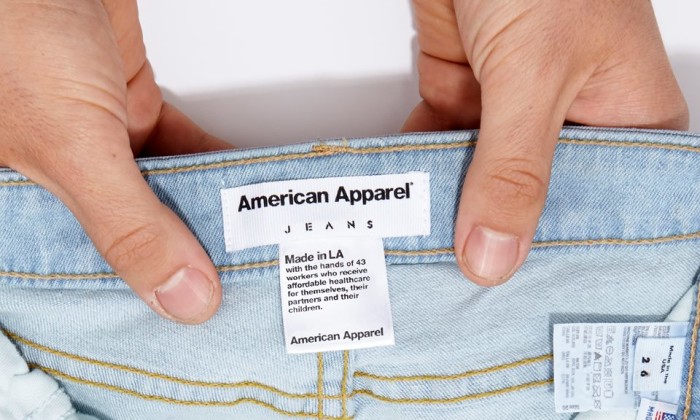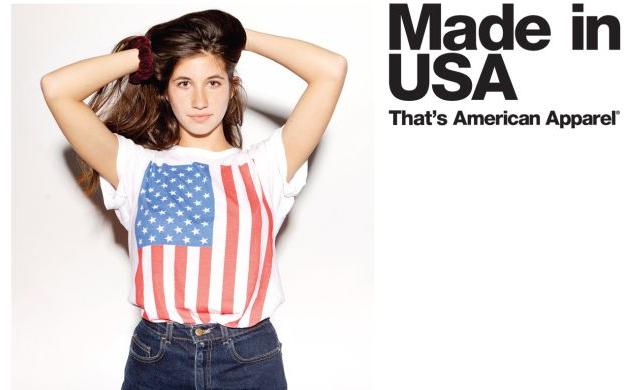Sourcing can be a loaded word for many entrepreneurs and small businesses keen on avoiding its connotations with “outsourcing”, a practice that resulted in many domestic employees losing their jobs and livelihoods. However, there is a distinction between sourcing and “outsourcing”. To source something is to simply find where you can get it. It can be local, national, or international. Where to source something is a question that every entrepreneur and businessman should carefully consider as it can have serious repercussions on their business strategy and viability. If a business only chose to source from the local level and refused to consider international options, what would it look like and what lessons can be learned from it? American Apparel is a perfect example of the benefits and risks of such a sourcing strategy.

American Apparel Jeans: Made in LA
American Apparel was founded in 1989 by Dov Charney, a man who was himself born in Montreal, Canada. Immigrants have always contributed to the fabric of America, and in Dov Charney’s case, literally. Dov’s idea for the company centered on keeping his sourcing local (downtown LA) and ensuring that workers at his factories were paid decent wages ranging from $12 to $18 an hour and also included benefits, a drastic difference from a majority of clothing manufacturers. However, complaints still arose among a few factory workers regarding excessive workloads and intimidation tactics to keep up with production demands. The company also put its weight behind social causes such as the push for marriage equality and the Fight for $15, the movement to increase the federal minimum wage in the US to $15 an hour. As it continued to develop, the brand eventually became a staple of American street fashion. Their success was driven, debatably and in part, due to Dov’s controversial and unorthodox marketing style. At it’s peak, American Apparel was the largest t-shirt manufacturer in the US and was successful in maintaining a local manufacturing base as they grew.

Made in Downtown LA
As sudden as their success seemed to be, many of American Apparel’s clientele were shocked when the brand filed for chapter 11 bankruptcy in 2015 after it was revealed that they had not made a profit since 2009. The board of directors also removed Dov Charney as CEO and eventually pushed him out of the company altogether, citing the sexual harassment controversies surrounding him that had bled into the brand. The original American Apparel finally met its end in 2016 after it filed for bankruptcy a second time following an unsuccessful attempt to save the company by interim CEOs. After the second filing, Gildan Activewear stepped in and purchased American Apparel’s intellectual property and a small portion of its original manufacturing operations. However, Gildan Activewear did not purchase any of American Apparel’s 204 retail stores (which had already been reduced from 240 after their first bankruptcy filing). With no buyers, the remaining retail locations were eventually phased out.

American Apparel Storefront
Coincidentally, Gildan Activewear is an apparel company founded and headquartered in Montreal, Canada, the same city where Dov Charney was born. In contrast to American Apparel, Gildan Activewear pursued cost cutting measures, automation, and readily outsourced their manufacturing. In fact, their cost cutting measures, in combination with automation, lowered their manufacturing costs to below those of comparable Chinese manufacturers. Their factories in Haiti have also come under scrutiny for harsh working conditions and their view of factory workers pay and benefits stands in stark contrast to those of American Apparel. After purchasing American Apparel’s intellectual property, Gildan Activewear announced plans to bring back the brand in an online only capacity. Although American Apparel is being revived in name, its ideals of local manufacturing and good pay and benefits for factory workers are no longer a major part of the brand.

Garment Factory in Haiti
It can be argued that if American Apparel had taken steps to tighten its operational costs, reduce the number of retail locations to focus on more profitable markets first, and developed a wider variety of products to compete with the rise of “fast fashion” brands (and avoid controversy that could alienate certain customers), they would have been able to maintain their local manufacturing structure and taken advantage of the “normcore” trend that would have complemented their product aesthetic. They would also have been able to prove to their many detractors that higher wages and local manufacturing are viable alternatives to outsourcing despite the increased costs. However, the combination of mismanagement and lack of spending oversight proved to be the undoing of the brand.

American Apparel by Gildan
For entrepreneurs and small businesses, making our operations as efficient as possible allows spending in the areas we truly care about. In short, the price of local manufacturing options are not always a deal breaker. Only when costs in other parts of the business go unchecked can it become a losing proposition.
Resources & Citations:
[1] The Atlantic’s Article Regarding American Apparel and Gildan
[2] Profile on Dov Charney by Bloomberg News
[3] Review of “No Sweat” Documentary on American Apparel’s Manufacturing
[4] The Fashion Law Profiles American Apparel
[5] Consumerist’s Article on Gildan’s Acquisition of American Apparel

Adu Makan
Freelance Writer

